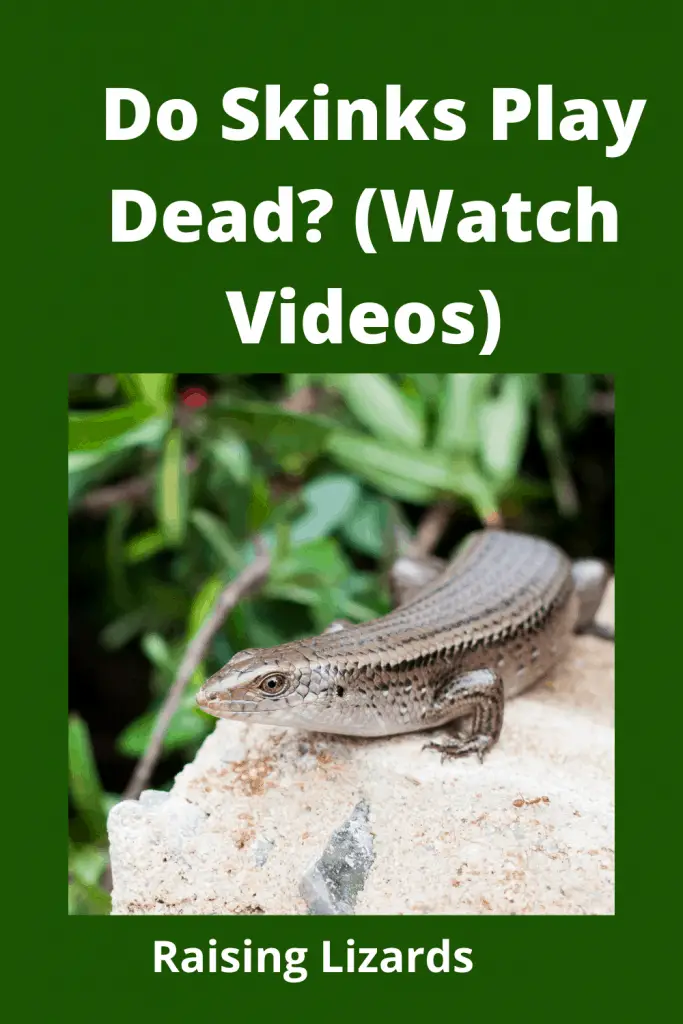Skinks Playing Possum
Skinks will Play Possum / Play dead under some of theses circumstances
- Being Handled
- If Felt Under Threat
- If Stressed / Frightened
- Defenses of Playing Dead / Vomiting / Loosing Tail
- Will Resume Normal Life when Predator / Cause has left their sight
- If Irritated or Had Enough
Skinks are lizards from the family Scincidae, a family present in the infraorder Scincomorpha. With more than 1,550 described species, the family Scincidae is one of the most diverse lizards’ families.
Skinks resemble with the lizards of the family Lacertidae (sometimes called real lizards), but most species of skinks have relatively small legs and no pronounced neck. Several genera (e.g., Typhlosaurus) do not have any limbs at all. However, this isn’t true for all skinks as some species, such as the Red Eyed Crocodile Skink, have a very distinguished head from the body.

Do Skinks Play Dead?
Oh yeah, they play dead most often. Especially if you’re holding them, they’ll do that all the time. It is quite an active hunter, but it may play dead to confuse its attacker if threatened.
We give you our real-life example when we just bought two beautiful crocodile skinks, but we were getting freaked out. We thought they were dead after we brought them home, but after leaving them alone with the lights out, they started moving around. On the internet, we saw that they play dead very often and are good at it.
They play dead so well that only an expert can differentiate between the dead or alive. Even they seem to stop breathing too.
We did see one of them move last month, they keep going back to the same location and position, so if we didn’t see her move, we would assume that she hadn’t.
How can We Tell if They are Dead or Not?
In that case, you wait and first observed from a far distance from where the skinks can’t see you. They play dead all the time when you are around, and you are not familiar with them.
Tiny Mirror
The most reliable solution is to put a tiny mirror near its nose and check cautiously if the mirror fogs up or not, or see behind its front legs for a pulse under the skin. If it fogs up, then your skink is making you fool.
Flashlight
Get a torch and look for a reaction in the pupils.
Camera’s
The other best way is to use cameras to check their activities.
Skinks, especially Crocodile skinks, are incredibly private critters and shy animals. It takes a long time for skinks to become ‘used’ to your regular traffic and activity patterns, mainly if your skinks are wild-caught adults.
Skinks seem to do best when their tank is located in an out-of-the-way area with reduced lighting. They seem to prefer having the tank covered with a cloth to reduce visibility, especially when feeding.
One of the facts is that only juveniles play dead, not the adults, but it usually depends upon the age of skinks, how old they are? and how familiar they are with you in a matter of trust?
We would suggest not putting too much pressure on them for a few days by planting. Ensure you have the right amount of humidity and moisture (70% humidity and almost any ‘room temperature’ that works for fine for them is in the mid-’70s).
Please provide them with an open dish of enough water to bathe, and plenty of places to hide. We have placed our skinks on an ‘eco-earth’ substrate, and to give a wet/dry gradient, we have a glass baking dish inside with bowls of water, which skinks like to sprinkle around the whole area. And usually make a big mess, soaking the substrate around.
The baking dish prevents overflow from completely saturating the entire tank. It would help if you used a fogger when the indoor air is arid, and skinks are often more active when the thick fog fills the tank.
Did we mention that skink being too shy to be caught in the wild?
Is my Skink Dead or Playing dead?
As earlier explained, lizards/Skinks are notorious for playing dead. Therefore, before taking into account that your lizard is dead, try poking it. And get a perfect look to see if it’s breathing or not.
Lose the Tail and Freeze!
This frightened skink does not like to fight. If a predator threatens the lizard, the skink’s barks first. If the hunter does not escape or tries to capture the skink, he will vomit and lose his tail before it can overturn and freeze. Most hunters think their prey is dead and will give up. After “playing dead” with the hunter, it will eventually grow its tailback.
Once a predator catches the skink’s tail, a tail causes the muscles to contract, and the tail is released from the skink’s body.
The energy stored in the tail is used to accelerate the rapid movement of the removed tail, Broken tail wiggles madly, which further confuses and distracts the predator. This discovery then goes away from the prediction attempt. The tail is usually recreated to regain some other function of the tail. In some trenches, the lost tail itself is more likely to escape the predator due to its violent beating.
Five-lined skinks and slender skinks often return to the area and eat their remaining tail, thus gaining some lost energy.
The Suit of Armor:
Like crocodiles, crocodile skins have four spikes on the back. They also have bony plates on their heads like helmets. All of these plates act as Armor suits to protect lizards from predators.
Its Mine and Only Mine:
Mother skins lay only one egg at a time. As soon as they lay eggs, mothers will spend the day wrapped around them. Female skinks are very protective of their young as long as they do not hatch because the male skinks are not around.
Talking lizards(Skinks)
Crocodile skins are just one of the lizards/skinks in the whole of the skinks and lizards, except Geckos, which can use their vocal cords. When they are threatened, they make a barking or squawking sound.
Other Protection
Many Skinks also avoid eating by predators by changing their color to match the background. The skinks usually take several seconds to spread the pigment on its skin, which becomes like its colors. This color change is made more effective if the skinks remain motionless.
Play Dead to escape from Natural Predators:
Even without a change of color, many skinks can effectively play dead, or, as we commonly call it, “play possum.” Many predators need the sound of vibration or movement to find out where the lizard is. So being completely tough can be an effective way to disappear from the predator’s menu.
When a predator is not chasing a lizard, he can do exciting and unusual things with his tongue. The tongues of reptiles can come in many different forms, and the tongues of skinks are usually either long and narrow with a spike at the end.

Essential Features in skinks:
- Due to the protective color (camouflage), the skinks can often be easily hidden in your residence.
- The Skinks are thinner/Slender than Geckos, with narrow heads and small eyes, a narrow neck that is as wide as a head, and smooth, shiny, fish-like scales on the surface of the skin.
- The pet skink feeds on invertebrates such as small insects.
- Skinks often move or wave their tails to direct predators away from their bodies. Tails of many species are brightly colored, increasing the distraction effect.
Exciting information about Skinks:
The skink head is covered by substantial bony scales, usually matching up in shape and size, while overlapping. Other related genera, such as Neoseps, have compact limbs and less than five digits on each foot.
Many skinks have tapered and long tails. They can shed it often if predators grab onto them. Such species usually regenerate the lost part of a tail, though imperfectly. A missing tail can grow back within around three to four months. Species with short tails have no special regenerative abilities.
Some skinks species are relatively small; Scincella lateralis typically ranges from 7.6 to 14.6 cm (3.2 to 5.8 in), more than half of the tail. Most skinks that are medium-sized have snout-to-vent lengths around 13 cm (4.8 in), although some grow larger; the Solomon Islands skink (Corucia zebra) is the largest known species and may attain a snout-to-vent length of some 36 cm (14.1 in).
Many pet experts and owner suggests that these lizards are not overly challenging to care for. However, because they are relatively new to the pet-trade, it may take a more experienced owner to understand how to keep them happy and healthy fully. Their habitat should be kept hot and humid, and they need access to UVB light for 12-14 hours a day.
Skinks Prices
| Species of Skinks | Lifespan | Largest Length | Price | |
|---|---|---|---|---|
| Blue Tongue Skinks | 20 Years | 24" | $199- $499 | |
| Schneider's Skinks | 20 Years | 18" | $ 60 | |
| Blue Tailed Skinks | 8 - 10 Years | 5" - 8.5" | $ 14.99 | |
| Red-Eyed Crocodile Skinks | 12 Years | 8" - 10" | $ 199 | |
| Monkey Tailed Skinks | 20 Years | 32" | $ 799 | |
Fire SkiRed-Eyed Crocodile Skinks | 12 Years | 8" - 10" | $ 188 - $ 279 | |
Lifespan
Size
Price


